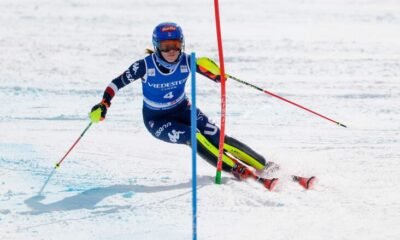Blog
Here We Go: U.S. Women Gear Up for Sölden Giant Slalom Season Opener
It’s finally here — the long-awaited start of the 2025–26 Alpine Ski World Cup season. The crisp air on the Rettenbach Glacier in Sölden, Austria, signals more than just another race. It’s a fresh beginning, a new chapter, and for Team USA’s women, a moment to test their form and spirit on one of the most iconic and unforgiving courses in the world.
As the bib numbers roll out, it’s clear the Americans are bringing depth and determination to the start gate. Paula Moltzan (bib 4), AJ Hurt (9), Nina O’Brien (11), Mikaela Shiffrin (20), Katie Hensien (25), Elisabeth Bocock (29), Mary Bocock (56), Tricia Mangan (59), and Keely Cashman (60) make up a powerful lineup — a mix of experience, grit, and rising talent.
And as Shiffrin herself posted with a smile, “Here we go 😅😅.”
The Tradition of Sölden
Sölden’s glacier has become synonymous with beginnings. It’s the place where the world’s best skiers gather each autumn to measure their progress after months of dryland training and glacier sessions. The season opener here is always more than a race; it’s a statement.
The course itself — icy, steep, and unpredictable — is as much about bravery as it is about skill. The giant slalom at Sölden tests a racer’s precision, power, and endurance. The two runs, separated by just a few hours, can feel like two completely different races as light and surface conditions shift rapidly.
For the American women, Saturday’s race represents a chance to make an early impact on the global stage. Fans back home will be tuning in bright and early — Run 1 begins at 4 a.m. ET, with Run 2 at 7 a.m. ET, live and replayed on Peacock.
Paula Moltzan Leads the Charge
Starting with bib number 4, Paula Moltzan is carrying the early momentum for Team USA. Over the past few seasons, Moltzan has built a reputation for her fearless skiing and technical sharpness. Her ability to attack the top section of the course — often where time is gained or lost — could put her in strong contention right from the opening run.
Moltzan’s approach is straightforward: no overthinking, just flow. She has become one of the most consistent American GS skiers outside Shiffrin, and her performances last season showed she’s ready to challenge for podiums. “You can’t fake confidence on this hill,” Moltzan said recently. “You either trust your line or you don’t.”
AJ Hurt and Nina O’Brien — Rising Together
Behind Moltzan are two young stars who’ve emerged as the backbone of the next generation: AJ Hurt and Nina O’Brien.
AJ Hurt (bib 9) is fast becoming one of the most exciting names in American alpine skiing. Her explosive starts and aggressive turns make her unpredictable — in the best way possible. She’s known for pushing the limits, and when she connects all the pieces, she’s capable of stunning results.
Nina O’Brien (bib 11), on the other hand, brings calm precision and technical mastery. After suffering a devastating crash during the 2022 Olympics, O’Brien’s comeback has been a story of quiet resilience. Every race now feels like a small victory. “The mountain doesn’t owe you anything,” she said earlier this month. “You earn your way back.”
Both Hurt and O’Brien starting within the top 15 reflects just how far the U.S. women’s program has come — depth and competitiveness at a level not seen in years.
Mikaela Shiffrin: The Calm Within the Chaos
And then there’s Mikaela Shiffrin, the face of modern alpine skiing. Wearing bib number 20, Shiffrin’s start position might seem later than usual, but that’s never stopped her before.
Coming into the 2025–26 season, Shiffrin carries both legacy and motivation. After surpassing the all-time World Cup wins record and continuing to balance success with personal recovery and renewal, she returns to Sölden with clarity and calm.
This opener may not define her season, but it sets the tone. “Sölden is about rhythm,” she once said. “You can’t win it in one turn, but you can lose it that way.”
Shiffrin’s relationship with the glacier is a familiar one. She’s been here in snow, fog, wind, and sun. She’s won and she’s struggled. But she’s never lost her respect for what this race represents — the starting line of a journey that will stretch across continents, ending next winter with the Olympics in Milan-Cortina.
The Next Wave: Hensien and the Bocock Sisters
In the second wave, Katie Hensien (25) and Elisabeth Bocock (29) bring youthful energy and quiet ambition. Both have impressed coaches during pre-season training, showing that the gap between veterans and newcomers in U.S. skiing is narrowing fast.
For Elisabeth Bocock, this race carries extra meaning as her younger sister, Mary Bocock (56), joins her on the start list. Two sisters racing together on the World Cup stage — it’s a rare and inspiring moment for American skiing. “We grew up chasing each other down mountains,” Elisabeth said. “Now we get to do it here. That’s special.”
Experience Meets Grit: Mangan and Cashman
Rounding out the American lineup are Tricia Mangan (59) and Keely Cashman (60), both of whom bring valuable experience to the team. Mangan, known for her analytical approach and relentless positivity, continues to find her groove after battling through injuries.
Cashman, too, has fought her way back from setbacks, displaying a level of resilience that defines this generation of U.S. athletes. She’s powerful, composed, and mentally tough — qualities that often shine on unpredictable glacier courses like Sölden’s.
Early Morning Magic for Fans Back Home
While it’ll be the middle of the night in much of the U.S., true fans know the thrill of setting the alarm for 3:45 a.m., grabbing coffee, and watching the first run live. For those who can’t make it, replays on Peacock will keep the excitement going all morning.
The atmosphere in Sölden, with its mix of local fans waving flags and the unmistakable hum of ski edges cutting into ice, is unlike anything else in sport. Every start gate holds both hope and fear — and every turn could decide a career.
Beyond the Bibs: A Team United
What makes this year’s U.S. women’s team so compelling isn’t just their talent — it’s their chemistry. You can feel it in Shiffrin’s caption, “Here we go 😅😅,” a simple, shared acknowledgment of nerves and excitement. This group celebrates each other’s successes, lifts one another through setbacks, and thrives on mutual respect.
There’s no rivalry that divides them — only competition that strengthens them. It’s a rare thing in elite sports, and perhaps that’s what will carry them through a long, demanding season.
The Start of Something Bigger
As the first racer pushes out of the gate, the sound of skis slicing through the ice will echo across the Alps and through living rooms worldwide. Every racer, from bib 4 to 60, will fight gravity, nerves, and doubt — for a shot at greatness.
For Team USA, it’s not just about medals yet. It’s about setting the tone — showing the world that American alpine skiing isn’t defined by one star but by a generation.
So when the cameras roll and the crowd roars, remember the words that started it all: Here we go.
-

 Blog4 months ago
Blog4 months agoPat Kelsey sends a strong three-word fiery message to the Louisville basketball’s team after their Cardinals 14th win…
-

 Blog7 months ago
Blog7 months agoNetflix releases “The Underdog,” a much-anticipated documentary about Drew Brees. slated for publication on the 25th
-

 Blog4 months ago
Blog4 months agoMikaela Shiffrin responds to cross-country skier Jessie Diggins’ letter following her failure to secure a solitary podium finish at the FIS Nordic Worlds
-

 Blog2 months ago
Blog2 months agoBehind the Turns: Netflix’s Upcoming Documentary on Mikaela Shiffrin’s Fights, Fears, and Love
-

 Blog4 months ago
Blog4 months agoWomen’s Slalom Run 1 at the FIS Alpine Skiing World Cup: Are
-

 Blog4 months ago
Blog4 months agoLegacy Tour Led Zeppelin has officially confirmed their 2026 reunion tour, which will be their first extensive live performances since 2007. The “Led Zeppelin Legacy Tour 2026” will begin on June 10, 2026, at Los Angeles’ SoFi Stadium.
-

 Blog6 months ago
Blog6 months agoFederica Brignone: “I’m fine, but my return to skiing is far off.”
-

 Blog6 months ago
Blog6 months agoAlice Cooper: From Fragile Boy to Shock Rock Icon—Netflix Unmasks the Nightmare
